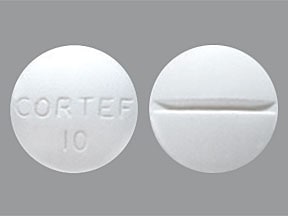Generic Name:
Hydrocortisone
Hydrocortisone sodium succinate
Brand Name:
Cortef
Solu-Cortef
Available Forms:
Hydrocortisone
Enema: 100mg/60 ml
Tablets: 5 mg, 10 mg, 20 mg
Hydrocortisone Sodium Succinate
Injection: 100-mg vial, 250-mg vial, 500-mg vial, 1000-mg vial
Indications and Dosages:
Severe inflammation, adrenal insufficiency
Adults: 5 to 30 mg P.O. b.i.d., t.i.d., or q.i.d. (as much as 80 mg q.i.d. may be given in acute situations). Or, initially, 100 to 500 mg succinate I.M. or I.V.; then 50 to 100 mg I.M., as indicated.
Shock
Adults: Initially, 50 mg/kg succinate I.V., repeated in 4 hours. Repeat dosage q 24 hours, p.r.n. Or, 100 to 500 mgto 2 g q 2 to 6 hours, continued until patient is stabilized (usually not longer than 48 to 72 hours).
Children: Succinate (I.M. or I.V.) o.16 to 1 mg/kg or 6 to 30 mg/m2 given once or twice daily.
Adjunct treatment for ulcerative colitis and proctitis
Adults: 1 enema (100 mg) P.R. nightly for 21 days. Or, 1 appplicatorful (90-mg foam) P.R. daily or b.i.d. for 14 to 21 days. Or, 25 mg rectal suppository b.i.d. for 2 weeks. For severe proctitis, 25 mg P.R. t.i.d. or 50 mg b.i.d.
Action
Corticosteroids
Decreases inflammation, mainly by stabilizing leukocyte lysosomal membranes; suppresses immune response; stimulates bone marrow; and influences protein, fat, and carbohydrate metabolism.
Route of Administration
P.O. – by mouth
I.V. – intravenous
I.M. – intramuscular
P.R. – per rectal
Side Effects:
CNS: euphoria, insomnia, psychotic behavior, pseudotumor cerebri, vertigo, headache, paresthesia, seizures
CV: heart failure, hypertension, edema, arrhythmia, thrombophlebitis, thromboembolism
EENT: cataracts, glaucoma
GI: peptic ulceration, GI irritation, increased appetite, pancreatitis, nausea, vomiting
GU: menstrual irregularities, increased urine calcium levels
Hematologic: easy bruising
Metabolic: hypokalemia, hyperglycemia, carbohydrate intolerance, hypercholesterolemia, hypocalcemia
Musculoskeletal: growth suppression in children, muscle weakness, osteoporosis
Skin: hirsutism, delayed wound healing, acne skin eruptions
Other: cushingoid state, susceptibility to infections, acute adrenal insufficiency after increased stress or abrupt withdrawal after long-term therapy
After abrupt withdrawal: rebound inflammation, fatigue, weakness, arthralgia, fever, dizziness, lethargy, depression, fainting, orthostatic hypotension, dyspnea, anorexia, and hypoglycemia. After prolonged use, sudden withdrawal may be fatal.
Contraindications:
Contraindicated in patients hypersensitive to drug or its ingredients, in those with systemic fungal infections, in those receiving immunosuppressive doses together with live virus vaccines, and in premature infants (succinate).
Nursing Considerations:
• Determine whether patient is sensitive to other corticosteroids.
• Most adverse reactions to corticosteroids are dose- or duration-dependent.
• For better results and less toxicity, give a once-daily dose in morning.
• Give oral dose with food when possible. Patient may need medication to prevent GI irritation.
• Give I.M. injection deeply into gluteal muscle. Rotate injection sites to prevent muscle atrophy. Avoid S.C. injection because atrophy and sterile abscesses may occur.
• Injectable forms aren’t used for alternate-day therapy.
• Only hydrocortisone sodium phosphate and sodium succinate can be given I.V.
• Enema may produce same systemic effects as other forms of hydrocortisone. If enema therapy must exceed 21 days, stop gradually by reducing use to every other night for 2 to 3 weeks.
• High-dose therapy usually isn’t continued beyond 48 hours.
• Always adjust to lowest effective dose.
• Monitor patient’s weight, blood pressure, and electrolyte level.
• Monitor patient for cushingoid effects, including modn face, buffalo hump, central obesity, thinning hair, hypertension, and increased susceptibility to infection.
• Unless contraindicated, give a low-sodium diet that is high in potassium and protein. Give potassium supplements.
• Drug may mask or worsen infections, including latent amebiasis.
• Stress (fever, trauma, surgery, and emotional problems) may increase adrenal insufficiency. Increase dosage.
• Watch for depression or psychotic episodes, especially during high-dose therapy.
• Inspect patient’s skin for petechiae.
• Diabetic patient may need increased insulin; monitor glucose level.
• Periodic measurement of growth and development may be needed during high-dose or prolonged therapy in children.
• Gradually reduce dosage after long-term therapy.

Hydrocortisone tablet is used to treat several conditions, which include allergic disorders, certain blood disorders, arthritis, ulcerative colitis, lupus, Crohn's disease, breathing disorders such as asthma, and skin conditions such as psoriasis. This medication is in a class of drugs called corticosteroids. It works by reducing inflammation, swelling, and irritation.
ReplyDeleteGreat information shared by you, i like it so much and i would like to huge thanks for this.
ReplyDeleteFind here cancer and anticancer medicine or drugs at affordable price. Sunatinb Sutant 12.5MG and 25MG.
Sutent is used in the treatment of renal cell carcinoma; gastrointestinal stromal tumor; pancreatic cancer and belongs to the drug classes multikinase inhibitors.
Was very helpful
ReplyDeleteWow, well understood
ReplyDeleteIt's good ,😍
ReplyDelete